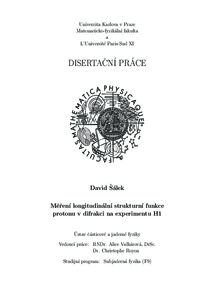Measurement of the Longitudinal Proton Structure Function in Diffraction at the H1 Experiment and Prospects for Diffraction at LHC
Měření longitudinální strukturní funkce protonu v difrakci na experimentu H1
rigorózní práce (UZNÁNO)

Zobrazit/
Trvalý odkaz
http://hdl.handle.net/20.500.11956/32929Identifikátory
SIS: 98888
Kolekce
- Kvalifikační práce [11196]
Autor
Fakulta / součást
Matematicko-fyzikální fakulta
Obor
Jaderná a subjaderná fyzika
Katedra / ústav / klinika
Ústav částicové a jaderné fyziky
Datum obhajoby
21. 1. 2011
Nakladatel
Univerzita Karlova, Matematicko-fyzikální fakultaJazyk
Angličtina
Známka
Uznáno
disertační práce, David Šálek Práce popisuje první měření longitudinální difrakční strukturní funkce protonu FD L s použitím H1 detektoru na urychlovači HERA. Strukturní funkce je určena z prvních měření difrakčního účinného průřezu ep → eXY při těžišt'ových energiích √ s = 225 a 252 GeV ve vysokých hodnotách inelasticity y a z nového měření při √ s = 319 GeV s použitím dat nabraných v letech 2006 a 2007. Předchozí H1 data s těžišt'ovou energií √ s = 301 GeV doplňují kinematické pokrytí potřebné k určení FD L v oblastech virtuality fotonu 2.5 < Q2 < 100 GeV2 a poměrné ztráty longitudinální hybnosti protonu 10−4 < xIP < 10−2 . Práce detailně popisuje veškeré korekční faktory a ladění simulace použité pro měření. Mezi tyto korekce patří efektivita rekonstrukce primárního interakčního bodu, dráhy propo- jující interakční bod s odezvou kalorimetru od odraženého pozitronu, efektivity nejrůznějších výběrových kritérií pro výběr případů hloubkového nepružného rozptylu (DIS) a difrakčních případů. Výsledky FD L jsou srovnány s teoretickými předpověd'mi založenými na NLO QCD fitech předchozích difrakčních dat a na modelech používajících barevný dipól. Práce též krátce...
of the Thesis by David Šálek I present the first measurement of the longitudinal diffractive structure function FD L using the H1 detector at HERA. The structure function is extracted from first measurements of the diffractive cross section ep → eXY at centre of mass energies √ s of 225 and 252 GeV at high values of inelasticity y, together with a new measurement at √ s of 319 GeV, using data taken in 2006 and 2007. Previous H1 data at √ s of 301 GeV complete the kinematic coverage needed to extract FD L in the range of photon virtualities 2.5 < Q2 < 100 GeV2 and fractional proton longitudinal momentum loss 10−4 < xIP < 10−2 . I describe in detail all corrections factors and tuning of the simulation needed for the mesaurement. These involve the efficiency of reconstructing primary interaction vertex, track linking the vertex and the cluster of the scattered positron, efficiencies of various cuts in the DIS and diffractive selections. I compare the measured FD L with the predictions based on the NLO QCD fits to previous diffractive data as well a model derived from a colour dipole approach. I also introduce the a diffractive physics programme at LHC. Both the physics topics and the hardware issues are briefly covered. Diffraction at LHC relies on fast timing electronics, and I present simulation of various...
